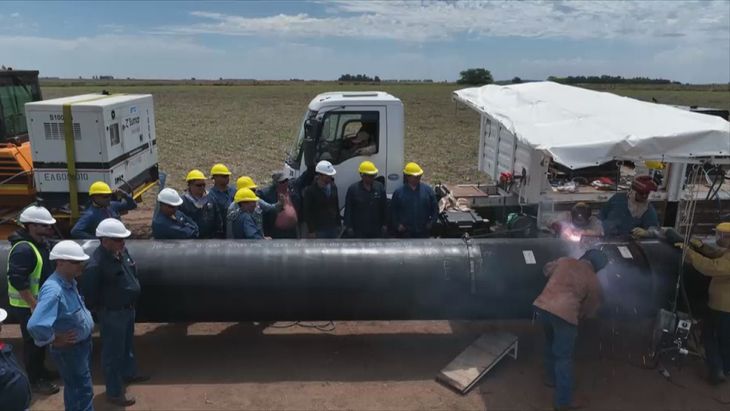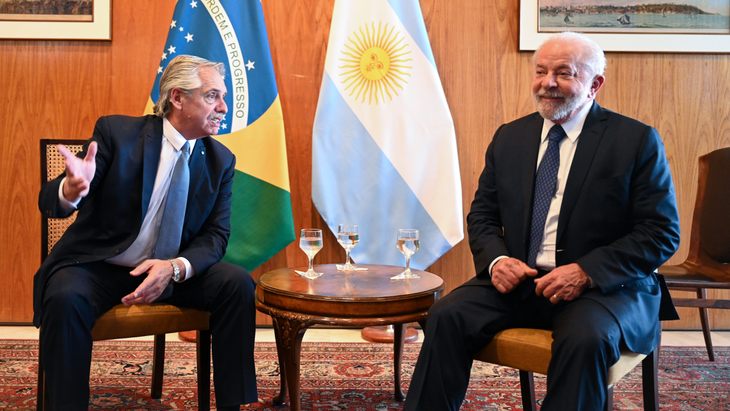In Chinathe Minister of Economy, Sergio Massaand the Secretary of Energy, Flavia Royónheld a meeting with company executives power chinawho showed their interest in participating in the mega project.
Powerchina already has a presence in Argentina, with the development of 5 wind farms with 355 Mw total and 4 Solar Parks of 412.6 MW total, with a total investment of u$s1,000 million. In turn, it participates in adjudication processes for other clean energy projects (hydroelectric), transport and electrical interconnection, road works and infrastructure.
In this case, the intention of power china would be to participate in the construction of the second section of the Nestor Kirchner pipelinewhich will cover the route from Salliqueló, in the Buenos Aires province, to San Jerónimo, in Santa Fe, and will contribute to continue transforming the energy matrix of our country.
pipeline.jpg
as revealed Scope through special envoy to Shanghai and then reproduced the state agency Télam, about the meeting with the Powerchina company, a high official source maintained that “They were interested in financing the second section of the gas pipeline, there is financing committed for US$1.9 billion.” However, the government expressed reservations about the proposal: “We are interested, but the Chinese times are longer than those proposed.”
“With them we have a commercial contract and therefore the bidding would not be necessary, but by the will and indication of the minister Sergio Massa, this second tranche will be tendered because we are working on other financing alternatives; the minister has given priority to the second section of the gas pipeline and the indication is that it must be tendered in August,” said the person consulted.
The bidding should be faced at the end of July, waiting for other markets, to reach August. The construction of the second and last part of 562 kilometers, It would take ten months and would incorporate compressor plants and surrounding pipelines.
For now, the only firm and closed thing is the US$540 million from the Development Bank of Latin America for the reversal of the Northern Gas Pipeline, which will help supply the importation of Bolivian gas. “The Gas Pipeline is clearly going to change Argentina,” he said a very first source of the energy sector to this medium.
https://twitter.com/FlaviaRoyon/status/1663622329857986562
PowerChina showed interest in financing the second section of the President Néstor Kirchner Gas Pipeline, which will cover the Salliqueló (Buenos Aires) – San Jerónimo (Santa Fe) route and will contribute to continue transforming the energy matrix of our country.
— Flavia Royon (@FlaviaRoyon) May 30, 2023
Massa and Royón held the meeting with Powerchina’s deputy chief economist, Ji Xiaoyong, but the president of Energía Argentina SA (Enarsa), Augustine Gerezthe state firm responsible for bidding for the construction, planning and execution of the project.
How is the work of the Néstor Kirchner Gas Pipeline
The first trunk trace of the Nestor Kirchner pipeline It has an extension of 573 kilometers. It joins the towns of Tratayén, in Neuquén, with Salliqueló, in the province of Buenos Aires, but it also crosses the provinces of Río Negro and La Pampa with a 36-inch pipe. It was built by the joint venture between Techint and Sacde (from Pampa Energía).
The construction was carried out in record time: 178 days from the first welding on November 16, 2022 in Salliqueló. According to reports from Enarsa, the state company in charge of the project, an average of five kilometers of pipes were welded per day on the three work fronts.
gas pipeline nestor kirchner salliquelo.jpg

In this work, automatic welders were used for the first time in the country, the most advanced technology worldwide that reduces work times. In total, more than 47,700 steel pipes 12 meters long produced by SIAT SAfrom Grupo Techint, with an approximate cost of US$500 million. All the pipes weigh approximately 300,000 tons of pipes, the equivalent of 4,285 Buenos Aires Obelisks.
The commissioning of the Nestor Kirchner pipeline It is scheduled for June 20, Flag Day, once the hydraulic tests have been completed, surface installations with their valves.
Brazil will also contribute US$600 million for the Néstor Kirchner Gas Pipeline
Alberto Fernandez received the notification in Brazil from his colleague Luiz Inacio Lula da Silva that there are no more legal obstacles to financing with the development bank BNDS for the construction of the second section of the Nestor Kirchner pipelinewhich will reach the Brazilian south.
As announced by the President, Brazil will finance the steel tubes and sheets produced there for the second phase of the gas pipeline that goes from the town of Salliqueló to San Jerónimo and other parts of the North Gas Pipeline, Salta-GNEA, Aldea Brasileira-Uruguaianato enter Brazil.
Alberto Fernandez and Lula da Silva.png

Official sources indicated that Brazilian financing will be around US$600 millionwhich will allow Argentina to achieve energy self-sufficiency and export gas from Vaca Muerta to Brazil, a global project estimated at US$5,000 million.
“Today we are making progress on strategic issues such as BNDES financing for exports of steel tubes and sheets that will be used in the second stage of construction of our Néstor Kirchner Gas Pipeline”explained Alberto Fernandez.
“This will allow our country to achieve energy self-sufficiency and export gas from Vaca Muerta to Brazil. In addition, we are taking fundamental steps to deepen our energy integration. Argentina will improve the payment conditions for electrical energy imports from thermal sources,” he explained. the head of state.
The Argentine ambassador in Brazil, Daniel Scioliratified that the neighboring country promised to “finance all the materials for the second stage of the gas pipeline that will allow us to export the surplus gas and that will have a very positive impact on our industry, which needs to be fed with inputs, raw materials, in order to continue advancing in this reindustrialization of the country”.
“The importance of this is that it will allow us to export the gas that Brazil needs, since Bolivia’s gas reserves are declining and with everything that Vaca Muerta is producing at the moment, it is very important that this gas can be transported. A lot of work has been done in recent days to be able to unlock and speed up this issue that is going to have a very important impact on our economy,” Scioli completed.
The benefits of the Néstor Kirchner pipeline
Thanks to the gas pipeline, more than US$4.200 million per year between fuel import substitution.
In addition, it will increase the availability of gas at competitive prices for industry, businesses and homes and will generate 10,000 direct jobs and others 40,000 indirect between the construction of the work and the greater production of gas in Vaca Muerta.
With the incorporation of the Salliqueló and Tratayén compression plants, it will be able to transport 21 million cubic meters of gas per dayand with the second stage between Salliqueló and San Jerónimo in Santa Fe they will complete 39 million mm3/dexpanding the main gas pipelines by 30%.
Source: Ambito




